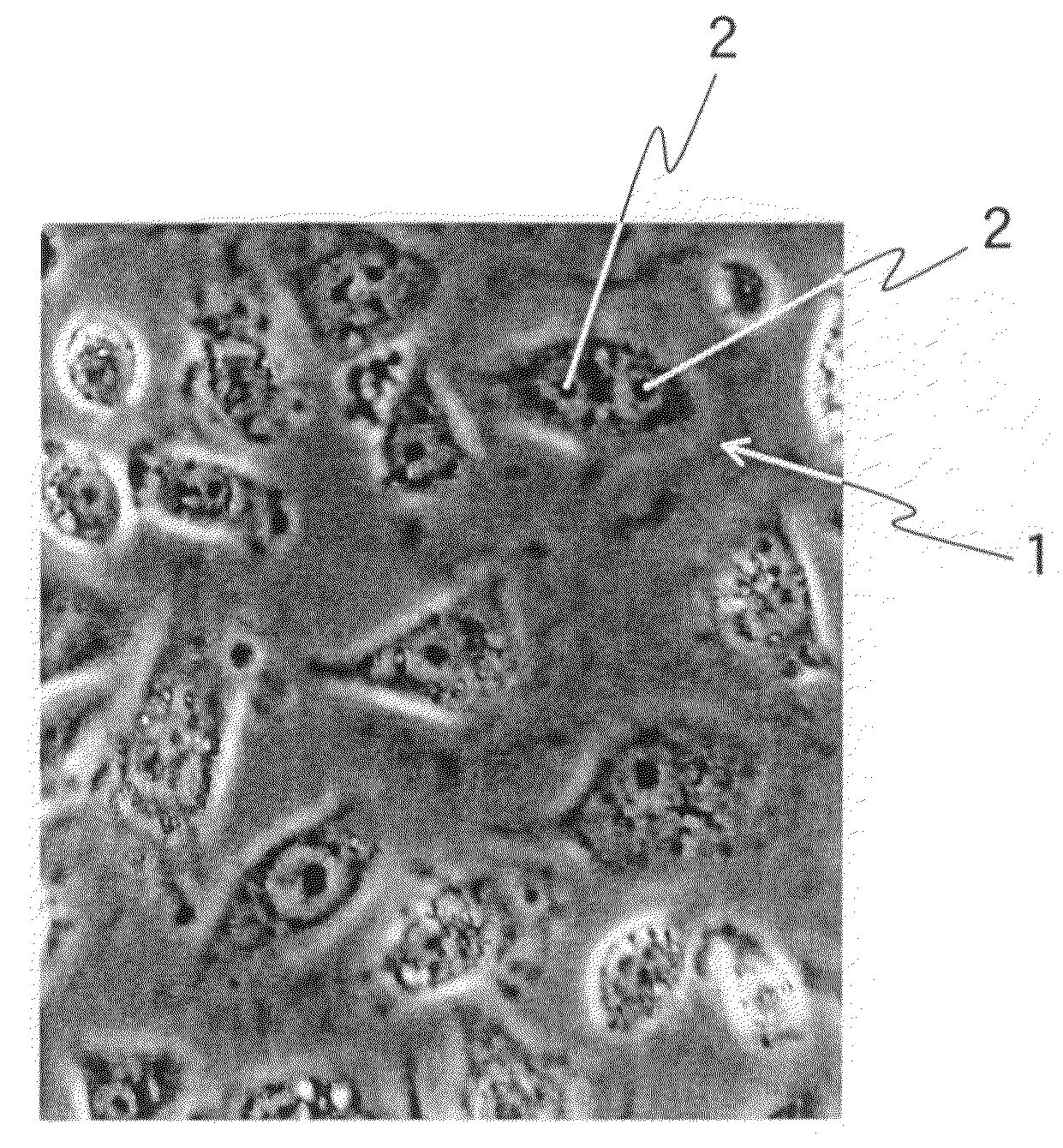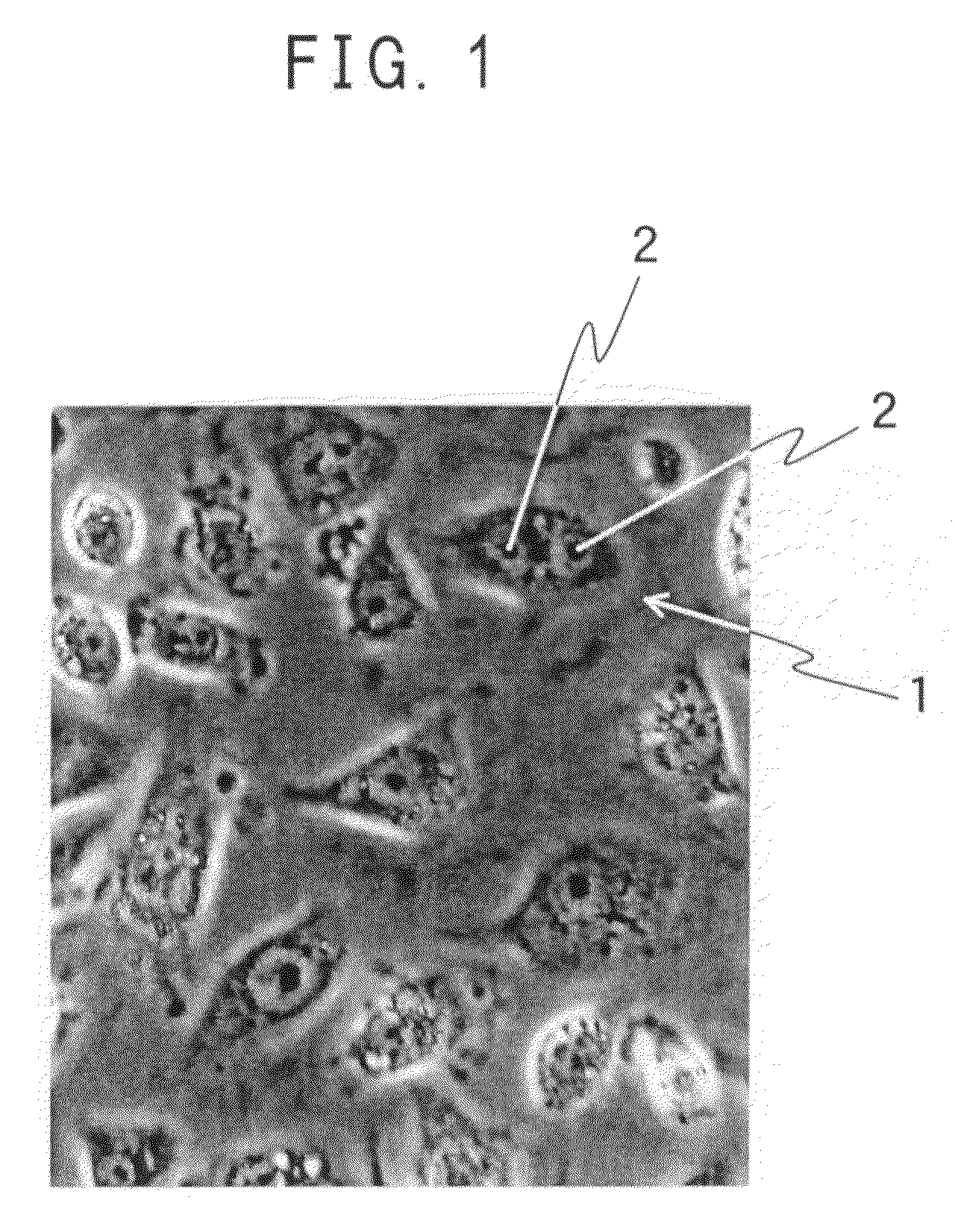Method of Inducing Differentiation of Embryo-Stem Cell Into Hepatocyte and Hepatocyte Induced by the Method
a technology of embryostem cells and methods, which is applied in the field of inducing embryostem cells into hepatocytes and hepatocytes induced by the method, can solve the problems of difficult to obtain, subject cannot receive merit, and serious liver disease is very dangerous for the life of a subj
- Summary
- Abstract
- Description
- Claims
- Application Information
AI Technical Summary
Benefits of technology
Problems solved by technology
Method used
Image
Examples
production example 1
Preparation of ES Cell
[0084]The ES cells derived from 129 v mice (bought from Dainippon & Sumitomo Pharmaceutical Co., Ltd.) were cultured using feeder cells (the mouse-derived embryonic fibroblast; bought from Dainippon & Sumitomo Pharmaceutical Co., Ltd.) in which neomycin resistance gene was introduced, using a culture flask T-75 (manufactured by Falcon Co. and sold by Becton Dickinson & Company) on which aqueous gelatin with a concentration of 0.1% (Catalogue No.: R-ES-006B, bought from Dainippon & Sumitomo Pharmaceutical Co., Ltd.). As the culture solution, a culture solution in which 15% fatal bovine serum (FBS), 1% non essential amino acid, 1% nucleotide, 110 μM of 2-mercaptoethanol (available from Dainippon & Sumitomo Pharmaceutical Co., Ltd.), 1% penicillin and streptomycin, 1% glutamic acid and 500 U / ml mouse derived leukemia inhibiting factor (LIF) (available from Dainippon & Sumitomo Pharmaceutical Co., Ltd.) were supplemented to a mix solution (a volume ratio of 1:1) of...
example 1
[0085]The differentiating induction culture of 5 million cells of the ES cells obtained in Production Example 1 to the hepatocyte was carried out by adding mouse derived dHGF of a concentration of 100 ng / ml (presented by Dai-ichi Kogyo Seiyaku Co., Ltd. (Tokyo)), bFGF of a concentration of 100 ng / ml, DMSO of a concentration of 1% (manufactured by Sigma-Aldrich Corporation) and dexamethasone of a concentration of 10−7 mol (manufactured by Sigma-Aldrich Corporation) in 10 ml of an ES differentiating induction medium (DMEM F12) in a culture flask T-75 (manufactured by Falcon Co. and sold by Becton Dickinson & Company) coated with aqueous gelatin of a concentration of 0.1% (Catalogue No.: R-ES-006B, bought from Dainippon & Sumitomo Pharmaceutical Co., Ltd.).
[0086]The composition of the DMEM F12 was a medium in which DMEM (GIBCO BRL, manufactured by Invitrogen Corporation) and a nutrition mixture F-12 (ham) (GIBCO BRL, manufactured by Invitrogen Corporation) was at a proportion of 1:1, 4...
example 2
[0087]The dispersion culture of 5 million cells of the ES cells obtained in Production Example 1 was carried out with a 10 cm sterilized petri dish (shallow type of 90×15 mm and commodity number; SH90-15, manufactured by Asahi Technoglass Corporation) for 5 days using 10 ml of the ES culture solution (R-ES-101), to form embryoid body.
[0088]Then, the mouse hepatocytes were induced in like manner as Example 1 except that the embryoid body was used in place of the ES cells.
PUM
| Property | Measurement | Unit |
|---|---|---|
| diameter | aaaaa | aaaaa |
| length | aaaaa | aaaaa |
| temperature | aaaaa | aaaaa |
Abstract
Description
Claims
Application Information
 Login to View More
Login to View More - R&D
- Intellectual Property
- Life Sciences
- Materials
- Tech Scout
- Unparalleled Data Quality
- Higher Quality Content
- 60% Fewer Hallucinations
Browse by: Latest US Patents, China's latest patents, Technical Efficacy Thesaurus, Application Domain, Technology Topic, Popular Technical Reports.
© 2025 PatSnap. All rights reserved.Legal|Privacy policy|Modern Slavery Act Transparency Statement|Sitemap|About US| Contact US: help@patsnap.com



